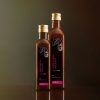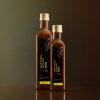
You’ve been asking a lot of questions about why we claim Anna’s Bee C is so amazing, where we take our honey from, if the raspberries come from Poland and if ascorbic acid is really such a savour of the humanity. Well, let me satisfy your curiousity with this hurried post 🙂
Indeed, our syrup is absolutely extraordinary – nothing like it was available on the market, so I simply had to create it for us.
We produce our Anna’s Bee C syrups in low temperature, taking extra care not to even get close to 38°C (100,4°F) over which raw honey starts losing its medicinal properties (bacteria, enzymes and vitamins die), while over 40°C (104°F) the very ascorbic acid itself starts to oxidize and disintegrate.
The honey we buy comes straight from the beehives in Warmia&Mazury (the cleanest lake districts in Poland): it’s raw, clean and unprocessed, which means it contains 100% of the claimed honey in honey, which unfortunately is not that obvious when buying it off the shelf in a store.
The raspberries we use come from local raspberry farmers. As long as we have stock, we use organic, but this year we’re planning to use organic raspberries only. Fingers crossed. We process them also in low temperature, so that they lose nothing of their dietary goodness, and thanks to enzymes, bacteria and vitamins proper absorption of the syrup is ensured.
Our L-ascorbic acid is, of course, food grade, and produced in the process of fermentation of non-GMO fruits and vegetables. As opposed to, let’s say, B vitamins – sourced often from petroleum, coal tar or acetylene gas – this vitamin C molecule is bioidentical and bioavailable, not synthetic and impossible to absorb by the human organism. Yes, the ascorbic acid is made in a lab, but it’s manufactured by bacteria in a fairly natural process, so it is identical to the vitamin c found in an apple, and recognized by the body as such.
Anna’s Bee C syrups are raw and pretty much alive, so they have ongoing processes in them. Even when stored in cool, they delaminate with time, which only shows how bioactive they are. Always remember to vigorously shake the bottle before using, as the thickest and most sour part goes always to the top, and can affect your facial expression. And if after a month or so the syrup will stratify significantly, you can shortly blend it and pour back into the bottle. It will then behave well for a while again 🙂
Right now, the suggested expiry date of the syrup is 3 months from the day of production, but I’m convinced once we finish our tests, it will officially be much longer. Such high concentration of both honey and ascorbic acid (used as preservatives in their own right) protects the syrup from going bad for many, many months.
I realise I could have made it all more practical – we could pasteurise the whole thing to death and stretch its expiry date to 2 years. But that wasn’t our goal at all. Our vitamin C is supposed to work exactly like in nature, and nature has not heard of pasteurization. We want Anna’s Bee C to give back to you everything it has in store, and to be maximally bioavailable, which is only possible in the presence of bacteria, enzymes, trace minerals, bioflavonoids, polyphenols, other synergisitc cofactors, antioxidants, phytonutrients and – what’s important – natural sugars. We want each ingredient to be medicinal in its own right, and in addition to complement and boost all the others as well.
Of course, it’s best to use strictly natural sources, but in order to have as much vitamin C in a teaspoon of our syrup, you’d need to eat 15 apples or 10 oranges! That’s simply impossible, especially with required 1 gram an hour in a viral infection, or when we want to strengthen our child’s immune system. So when we need a quick fix, we can take this super-concentrated dose and know it’ll work as if we ate those 10 oranges. Every 30 minutes 🙂
Yes, I did consider using powdered acerola or wild rose hips, but the problem with them is that from the very moment of their production, they start losing vitamin C. After a few months of unknown transport conditions and who-knows-how-warm-storage, nobody can really tell any more how much vitamin C is in there. I, on the other hand, was looking for a guarantee of the highest potency and a sure mega-dose of vitamin C. This is why a bioidentical L-ascorbic acid molecule, drowned in a cocktail of honey and raspberry goodness became an ideal solution.
I’m stubborn about sticking to the dark, glass bottle, as I have no intention of storing acid, weak as it is, in plastic containers, while sun rays and temperature cause vitamin C to oxidize.
If you want your Anna’s Bee C to stay maximally potent, keep it in the fridge, care for it like it’s a sweet, little pet and it’ll repay you with the whole friendliness of the life it hides inside 🙂


 Polski
Polski
